MANUEL CHILI CASPICARA
Further images
-
(View a larger image of thumbnail 1
)
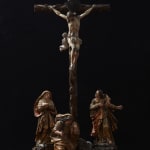
-
(View a larger image of thumbnail 2
)

-
(View a larger image of thumbnail 3
)

-
(View a larger image of thumbnail 4
)

-
(View a larger image of thumbnail 5
)
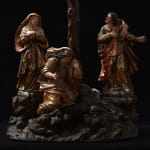
-
(View a larger image of thumbnail 6
)
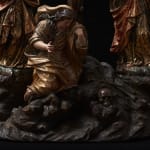
-
(View a larger image of thumbnail 7
)

-
(View a larger image of thumbnail 8
)
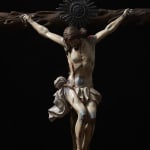
-
(View a larger image of thumbnail 9
)
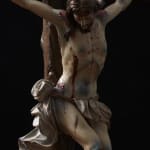
-
(View a larger image of thumbnail 10
)

-
(View a larger image of thumbnail 11
)
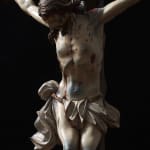
-
(View a larger image of thumbnail 12
)

Provenance
Private Collection.
The episode in Christ’s Passion involving the Crucifixion is one of the most representative in colonial-era sculpture in Quito. Generally, the Calvary scenes undertaken for the city’s reredos and oratories present Christ accompanied by his Mother, the Virgin Mary, Mary Magdalene and Saint John. The base is a structure that simulates stone and represents the little mount of Golgotha, on which rest the skull and bones that allude to Adam.
In the centre, on the mount of Golgotha, the Cross towers over the composition. Christs is depicted with his face looking down, his mouth half-open, already dead, and although this is a highly dramatic moment, he transmits a certain peace now that all his suffering is over. His powerfully contoured hair ruffles in a dynamic fashion, his face, eyes and half-open mouth display a grimace of great pain.
His body was sculpted in pale white with a powerful sense of naturalism, highlighting traces of blood on his hands, knees and feet. Little trails of blood trickle through his thick beard onto his neck and run down his body, further bringing out the whiteness of his skin where his wounds and stigmata contrast strongly with their purple colour, denoting the suffering Christ went through prior to his Crucifixion. The blood and wounds are highlighted by thousands of little rubies and diamonds that reflect the light, and add further dramatism to this Passion scene. His pubis is covered by a perizoma loincloth, a white cloth with broad folds attached to his body with a cord, finely carved with a great sense of naturalism. His lacerated feet are attached to the foot support by one single nail.
The Mother of Christ is depicted at the foot of the Cross, in an attitude of resignation with her arms crossed against her breast, hugging herself in a demonstration of her great pain and grief. Mary Magdalene is on her knees with her right arm stretched out while her left hand holds her veil, looking disconsolate at the skull and bones of Adam. On the right-hand side we find Saint John with his arms open, sobbing. All express great sorrow and despair, which Caspicara manages to transmit using great skill in the work’s colouring, with subtle differences in the reddish tones around the eyes which show tear tracks, thereby revealing his fine command of expressive execution.
It is worth highlighting the great “estofado” and graffito work seen in the garments, the subtle and varied tones and skill
shown in executing the folds and the sense of depth.
It possible that this Passion group may have formed part of a “locus orandi”, or devotional place where the faithful would go to pray in private, and where it was common to find images of the Crucified Christ alone. In this case, the presence of the Virgin Mary, Mary Magdalene and Saint John only go to intensify the moment of meditation and to invite female believers to imitate the observing figure of the Virgin Mary.
As is characteristic of works by Caspicara, the hands lend tone to the work, and their position forms a dramatic gesture of supplication. An intensely emotive and theatrical execution of the sculpture aimed at evoking feelings of empathy in the spectator. In the way the psychological aspects of character are executed in both the face and posture of the Virgin, the artist is providing spectators with a mirror on to her own pain due to the suffering of Christ.
From Spain’s earliest incursions at the Royal Court of Quito, the evangelisers promoted Seville’s ceremonial format, in which Christ’s Passion played the most important role in the Holy Week processions
Through dramatic sermons and expressive images they provoked emotive responses from the faithful, who looked upon the Passion images in their private oratories. The prayers of the Stations of the Cross or the reading of pious works called for visual aids in order to establish a spiritual colloquy as Saint Ignatius would have suggested.











